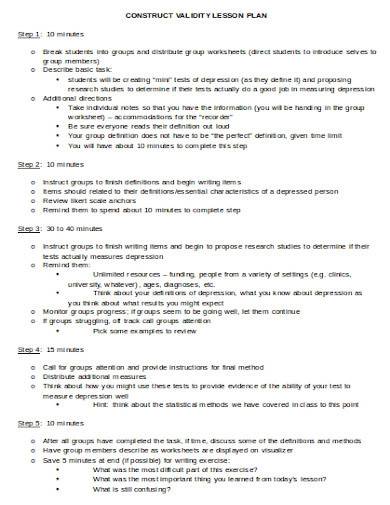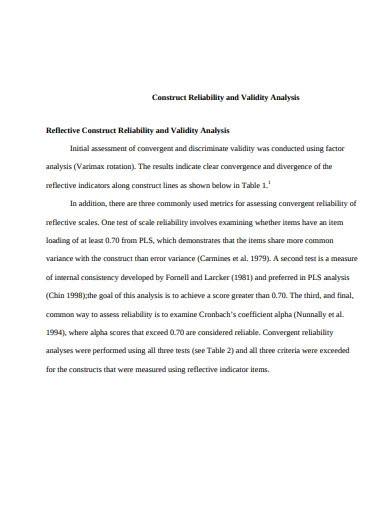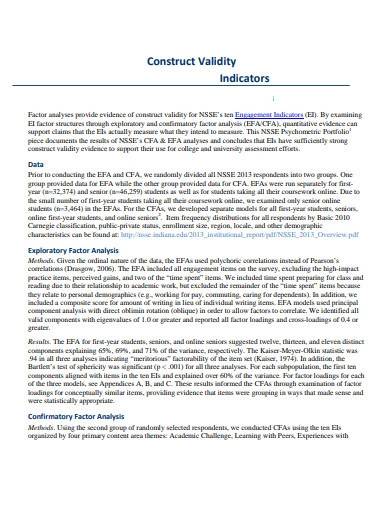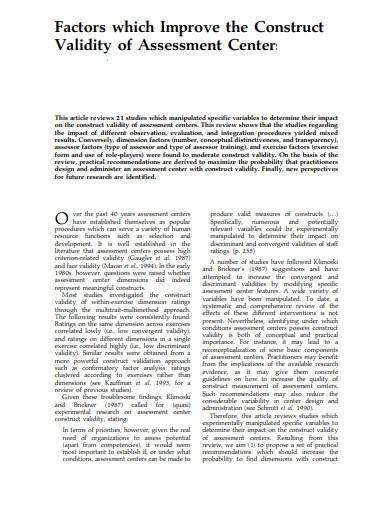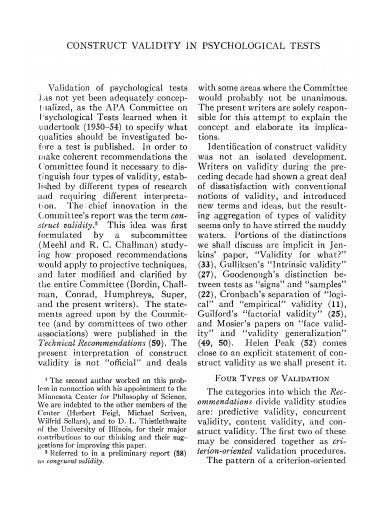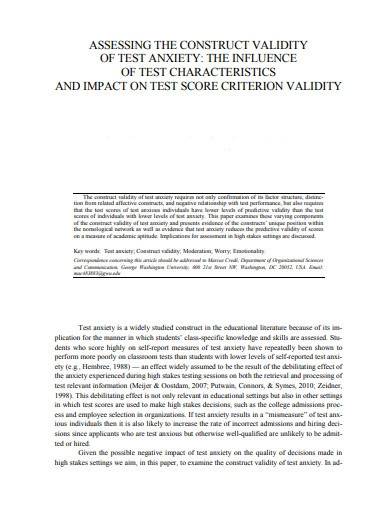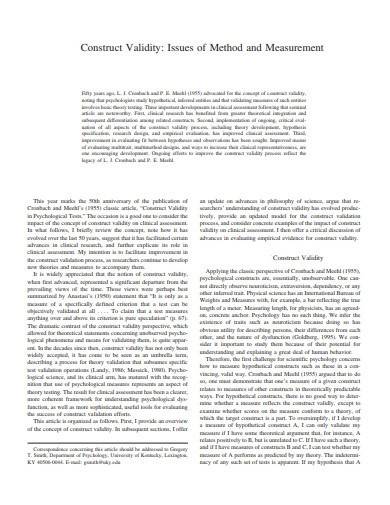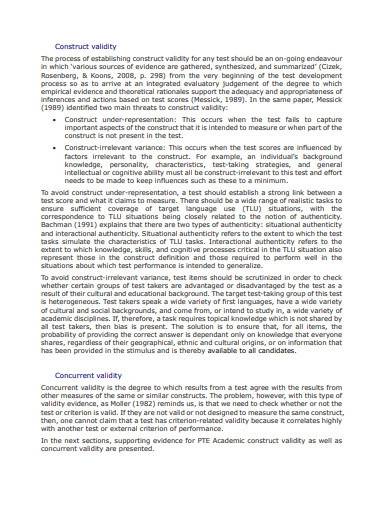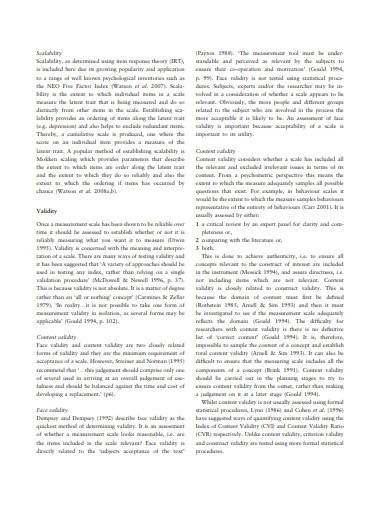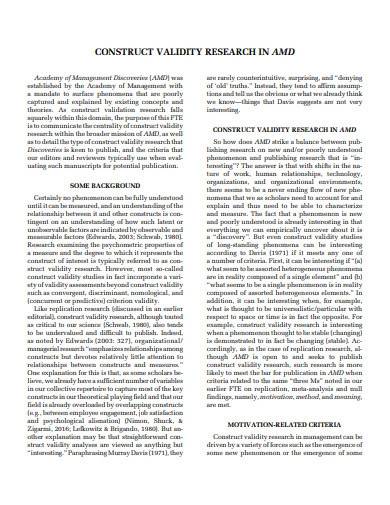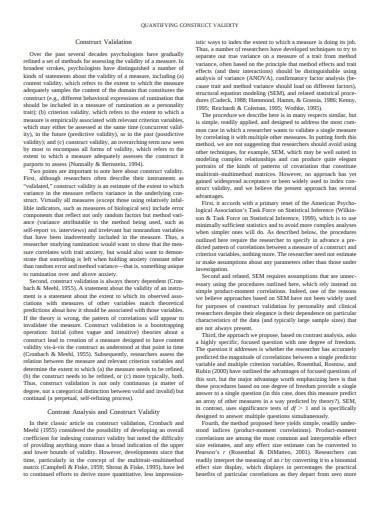A construct refers to a theoretical concept, idea, or theme that were based on factual observations. This concept is a variable that is commonly not directly measurable and can range from simple to complex. Simple constructs are inclined to be narrowly described while complex constructs are broader and created with dimensions. There are different methods to measure the validity of different tests and one of them is construct validity.
FREE 10+ Construct Validity Samples & Templates in MS Word | PDF
1. Construct Validity Lesson Plan Template
2. Construct Reliability & Validity Analysis
3. Construct Validity Indicators Template
4. Construct Validity Assessment Template
5. Construct Validity in Psychological Test
6. Assesing Construct Validity Template
7. Sample Construct Validity Template
8. Sample Construct Concurrent Validity
9. Content Construct Validity
10. Construct Validity Research Template
11. Sample Quantifying Construct Validity
What is a Construct Validity?
Construct validity is a method utilized to identify how well a test can measure an element it is supposed to measure. It involves verification by comparing the test to another test that aims to measure the same qualities to determine how they are highly correlated to each other. Construct validity is also an essential method to perform when testing an idea or concept that is difficult to measure directly. This type of validity is commonly used in social sciences, psychology, and education. There are other types of research that examiners studies such as longitudinal research, causal research, comparative research, exploratory research, descriptive research, and more.
How to Create Construct Validity
Validity determines how well an analysis of assessment measures what is supposed to measure. One type of validity is construct validity which assesses how well the assessment measures the construct it intends to measure. When used as a procedure in a research paper, construct validity is an important factor in operating constructs into measurable characteristics that are relevant to the idea of the construct and its related dimensions.
Step 1: Perform a Pilot Study
A pilot study refers to the trial run of a research study plan. This process is where you test out your measure with a sample to assess its feasibility, validity, and reliability. Pilot studies will help you determine whether revision of your measurement is necessary or not.
Step 2: Conduct Statistical Analysis
Statistical analysis is usually applied to test the validity of the data collected from your measures. In this analysis, you will be testing convergent and discriminant validity with interrelationships to determine whether the result from the tests are positively or negatively related to other established tests.
Step 3: Use Regression Analysis
You can utilize regression analysis to determine if the measure is predictive of results that you are expecting it to predict theoretically. This analysis supports your expectations, strengthening your claim of construct validity.
Step 4: Determine Threats
Another part of construct validity is recognizing and countering threats to empower your research design. Some of the common threats include poor operationalization, experimenter expectancies, and subject bias.
FAQs
What are the types of construct validity?
The main types of construct validity are convergent validity which measures correspond to the measure of a related construct and discriminant validity which measures unrelated to measures of distinct constructs.
What are the threats to construct validity?
The main candidates to threaten construct validity are research hypothesis guessing, evaluation apprehension, researcher expectancies and bias, poor construct definition, construct confounding, the interaction of various treatments, unreliable scores, mono-operation bias, and mono-method bias.
What is the importance of construct validity?
With construct validity, you can ensure that you are actually measuring the construct that you intend to measure. Otherwise, you might unintentionally measure irrelevant constructs and lose accuracy and precision in your research study.
Construct validity helps you in determining how well your assessment can measure the construct it is supposed to measure. This validity has two subtypes which are convergent validity and discriminant validity which are both utilized to establish how well a test analyzes the element it is meant to analyze. Construct validity is one of the four types of measurement validity, including content validity, face validity, and criterion validity.
Related Posts
FREE 10+ Concurrent Validity Samples & Templates in MS Word | PDF
FREE 10+ Resource Tracking Samples & Templates in MS Word | PDF
FREE 4+ Clinical Case Study Samples & Templates in PDF
FREE 10+ Content Validity Samples & Templates in PDF
FREE 10+ Code of Human Research Ethics Samples & Templates in MS Word | PDF
FREE 10+ Biography Research Report Samples and Templates in PDF
FREE 10+ System Documentation Samples & Templates in MS Word | PDF
FREE 10+ Process Document Samples & Templates in MS Word | PDF
FREE 10+ Action Research Samples & Templates in PDF
FREE 10+ Longitudinal Research Samples & Templates in PDF | MS Word
FREE 10+ Causal Research Samples & Templates in MS Word | PDF
FREE 10+ Client Discovery Samples & Templates in MS Word | PDF
FREE 10+ Null Hypothesis Samples & Templates in MS Word | PDF
FREE 9+ Product Knowledge Samples & Templates in PDF
FREE 10+ Software Documentation Samples & Templates in MS Word | PDF

